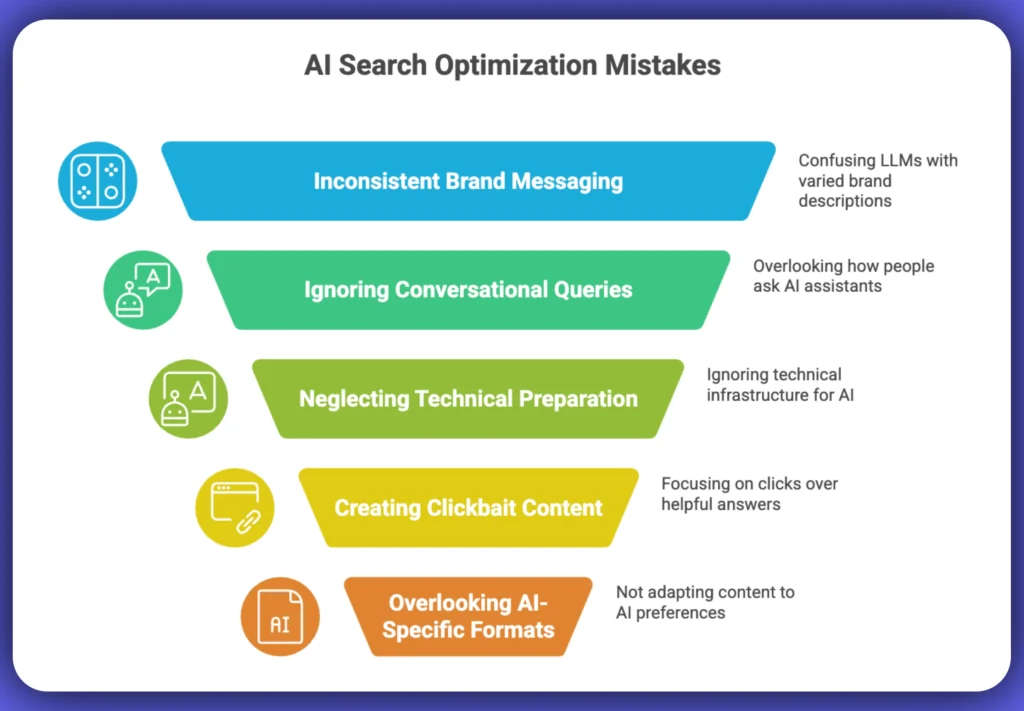Most startups are making the same critical mistake with AI search optimization: they’re treating it like traditional SEO with a few tweaks, when it’s actually a completely different game. While the foundation of LLM optimization overlaps substantially with traditional SEO, they aren’t exactly the same. The result? Your competitors are capturing AI-powered traffic while your startup remains invisible in ChatGPT, Claude, and Perplexity results.
Here’s the brutal truth: if you’re not optimizing for AI search right now, you’re essentially handing over a massive growth channel to competitors who understand the shift. The winning startups are the ones that are recognized by AI search.
Table of Contents
The Scope of the Problem: Why AI Search Matters for Startups
AI search platforms like ChatGPT, Perplexity, and Google’s AI Overviews are fundamentally changing how your customers discover solutions. Unlike Google, where users scroll through ten blue links, AI search delivers one authoritative answer. If you’re not in that answer, you don’t exist.
For startups, this creates both unprecedented opportunity and existential risk. Get it right, and you can capture qualified traffic from day one. Get it wrong, and you’ll watch established competitors dominate the conversation around your market.
Right now, 34% of AI crawler requests result in 404 or other errors, which means most companies aren’t even technically prepared for AI discovery, let alone strategically optimized.
Mistake #1: Treating AI Search Like Traditional SEO
The Problem: Most startups approach AI search optimization by adapting their existing SEO strategies, GEO is not the same as SEO, focusing on keywords and backlinks rather than understanding how large language models actually work.
What’s Actually Happening: AI systems don’t crawl and rank pages like Google. They’re trained on vast datasets and look for authoritative, context-rich information that directly answers user queries. Your keyword-stuffed blog post might rank on Google but will never appear in ChatGPT results.
The Fix: Shift from keyword optimization to context optimization. Instead of targeting “best project management software,” create comprehensive content that explains project management challenges, solutions, and decision frameworks. AI systems prefer content that demonstrates deep understanding over content that games algorithms.
Practical Implementation:
- Write content that answers the “why” and “how,” not just the “what”
- Include relevant context and background information in every piece
- Structure information hierarchically (main concepts → subconcepts → examples)
- Focus on topics, not keywords
Mistake #2: Inconsistent Brand Messaging Across Platforms
The Problem: Startups often have different descriptions of their product across their website, social media, and marketing materials. This inconsistent communication of the one-line summary of the brand’s product across subpages, social media, different pieces of content can confuse LLMs.
What’s Actually Happening: AI systems synthesize information from multiple sources to form understanding. When your messaging is inconsistent, AI models can’t confidently recommend your solution or might present conflated information about your offering.
The Fix: Develop and maintain a consistent “AI-friendly” brand narrative across all digital touchpoints.
Practical Implementation:
- Create a master brand description (2-3 sentences) and use it everywhere
- Audit all digital properties for messaging consistency
- Ensure your LinkedIn, website, and social media profiles tell the same story
- Include consistent value propositions and key differentiators across platforms
Mistake #3: Ignoring Conversational Query Optimization
The Problem: Startups optimize for Google search queries (“project management tools comparison”) but ignore how people actually ask AI assistants (“What’s the best project management tool for a 10-person startup with remote team members?”).
What’s Actually Happening: AI search queries are longer, more conversational, and context-heavy. Users provide more background information because they expect AI to give personalized recommendations.
The Fix: Optimize for conversational, context-rich queries that include situational details.
Practical Implementation:
- Create FAQ sections that mirror natural language questions
- Include scenario-based content (“For startups with X situation, Y solution works best”)
- Use conversational language in headings and subheadings
- Address common follow-up questions within your content
Mistake #4: Neglecting Structured Data and Technical Preparation
The Problem: Many startups focus on content optimization while ignoring the technical infrastructure needed for AI discovery. Only Google’s Gemini and AppleBot currently render JavaScript among major AI crawlers.
What’s Actually Happening: AI crawlers have different technical requirements than traditional search bots. Your site might be perfectly optimized for Google but completely invisible to AI systems.
The Fix: Implement AI-specific technical optimizations alongside your content strategy.
Practical Implementation:
- Add comprehensive schema markup for your products/services
- Ensure critical content loads without JavaScript dependency
- Implement clear site structure with logical information hierarchy
- Create XML sitemaps specifically for AI crawler access
- Test your site’s accessibility across different AI crawler types
Mistake #5: Creating Content for Clicks Instead of Answers
The Problem: Startups often create clickbait content designed to drive traffic rather than genuinely helpful content that provides complete answers.
What’s Actually Happening: AI search may provide a more engaged audience and new opportunities with visitors, but you might not optimize for these if you focus too much on clicks instead of the overall value of your visits. AI systems prioritize content that fully addresses user queries over content designed to generate clicks.
The Fix: Focus on creating comprehensive, standalone valuable content that completely answers user questions.
Practical Implementation:
- Write content that could standalone as a complete resource
- Include actionable advice and specific examples
- Provide context and background information, not just quick tips
- Structure content so AI can extract specific, quotable insights
Mistake #6: Overlooking AI-Specific Content Formats
The Problem: Startups continue creating traditional blog posts and web pages without adapting to formats that AI systems prefer and can easily parse.
What’s Actually Happening: AI systems excel at extracting information from well-structured, hierarchical content but struggle with dense paragraphs or complex formatting.
The Fix: Adapt content formats for AI consumption while maintaining human readability.
Practical Implementation:
- Use clear headings and subheadings to organize information
- Include bulleted lists for key points and features
- Create comparison tables for different solutions or approaches
- Write concise paragraphs that make single, clear points
- Include summary sections for complex topics
Mistake #7: Not Building Topical Authority in Your Niche
The Problem: Startups create scattered content across random topics instead of building deep expertise in their specific domain.
What’s Actually Happening: AI systems rely heavily on domain authority and topical expertise when deciding which sources to cite. A startup that occasionally writes about project management won’t compete with one that consistently demonstrates deep project management expertise.
The Fix: Build systematic topical authority through consistent, expert-level content creation.
Practical Implementation:
- Map out all subtopics within your domain expertise
- Create comprehensive content clusters around each subtopic
- Regularly publish insights based on your unique experience and data
- Connect related pieces of content through internal linking
- Establish your founders as thought leaders through consistent expert commentary

The Strategic Framework for AI Search Success
Successful AI search optimization requires a different mindset than traditional SEO. Instead of thinking about rankings and traffic, think about becoming the authoritative source AI systems turn to when users ask about your domain.
Phase 1: Foundation (Months 1-2)
- Audit and standardize all brand messaging across platforms
- Implement technical requirements for AI crawler access
- Create comprehensive FAQ sections addressing conversational queries
Phase 2: Content Development (Months 2-4)
- Build content clusters around your core expertise areas
- Create comparison and decision-making frameworks
- Develop scenario-based guidance for different user situations
Phase 3: Authority Building (Months 4-6)
- Establish consistent thought leadership content
- Build relationships and citations within your industry
- Create comprehensive resources that become go-to references
Phase 4: Optimization and Scaling (Ongoing)
- Monitor AI search results for your key topics
- Continuously refine content based on AI system preferences
- Expand into adjacent topics as authority grows
Measuring Success in AI Search
Traditional metrics like rankings and click-through rates don’t apply to AI search. Instead, focus on:
Direct Metrics:
- Mentions in AI search results for your key topics
- Quality and context of AI-generated summaries about your brand
- Frequency of recommendations across different AI platforms
Business Impact Metrics:
- Qualified lead generation from AI-influenced traffic
- Brand recognition improvements in target markets
- Conversion rates from users who mention finding you through AI search
Authority Metrics:
- Citations by other authoritative sources in your space
- Speaking opportunities and expert recognition
- Industry partnerships and collaboration requests
The Competitive Advantage of Getting AI Search Right
The startups that master AI search optimization now will have a massive first-mover advantage. If you don’t start optimizing for LLMs now, competitors could establish themselves in AI results and capture the majority of available exposure and visits.
Unlike traditional SEO, which can take months or years to show results, AI search optimization can deliver qualified traffic and brand recognition much faster, if you understand the fundamentals and avoid these common mistakes.
The key is recognizing that AI search isn’t just another marketing channel, it’s becoming the primary way your customers discover and evaluate solutions. The startups that treat it as such, rather than as an afterthought to their Google SEO strategy, will dominate their markets in 2025 and beyond.
